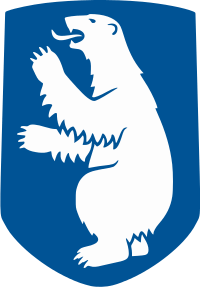The flag of Greenland was designed by Greenland native Thue Christiansen.[2] It features two equal horizontal bands of white (top) and red with a large disk slightly to the hoist side of centre. The top half of the disk is red, the bottom half is white. The entire flag measures 18 by 12 parts; each stripe measures 6 parts; the disk is 8 parts in diameter, horizontally offset by 7 parts from the hoist to the centre of the circle, and vertically centered.
Its local name in the Greenlandic language is Erfalasorput, which means "our flag". The term Aappalaartoq (meaning "the red") is also used for both the Greenlandic flag and the flag of Denmark (Dannebrog). Today, Greenlanders display both the Erfalasorput and the Dannebrog—often side-by-side. The flag of Greenland is the only national flag of a Nordic country or territory without a Nordic Cross.
History
Greenland first entertained the idea of a flag of its own in 1973 when five Greenlanders proposed a green, white and blue flag. The following year, a newspaper solicited eleven design proposals (all but one of which was a Nordic cross) and polled the people to determine the most popular. The flag of Denmark was preferred to the others. Little came of this effort.
In 1978, Denmark granted home rule to Greenland, making it an equal member of the Danish Realm. The home rule government held an official call for flag proposals, receiving 555 (of which 293 were submitted by Greenlanders).

Flag of Greenland construction.
The deciding committee came to no consensus, so more proposals were solicited. Finally the present red-and-white design by Christiansen narrowly won over a green-and-white Nordic cross by a vote of fourteen to eleven.[3] Christiansen's red-and-white flag was officially adopted on 21 June 1985.[2]
To honour the tenth anniversary of the Erfalasorput, the Greenland Post Office issued commemorative postage stamps and a leaflet by the flag's creator. He described the white stripe as representing the glaciers and ice cap, which cover more than 80% of the island; the red stripe, the ocean; the red semicircle, the sun, with its bottom part sunk in the ocean; and the white semicircle, the icebergs and pack ice. The design is also reminiscent of the setting sun half-submerged below the horizon and reflected on the sea.[1] In 1985, the public was made aware that Greenland's flag had exactly the same motif as the flag of the Danish rowing club, HEI Rosport, which was founded before Greenland's flag was chosen. It is not clear whether this is a case of plagiarism or just a coincidence, but the rowing club has given Greenland permission to use their flag.[4]
The colours of the Erfalasorput are the same as those of the Dannebrog, symbolizing Greenland's place in the Danish realm.
Other proposals
 |
 The first serious proposal from 1973, suggesting green, white and blue would be appropriate The first serious proposal from 1973, suggesting green, white and blue would be appropriate |
|
|
 |
 Anonymous proposal in 1991 (white for the ice of Greenland, green for the name "Greenland") Anonymous proposal in 1991 (white for the ice of Greenland, green for the name "Greenland") |
|
 |
 Another proposal based heavily on the Dannebrog Another proposal based heavily on the Dannebrog |
|
Similar flags
See also
References
External links
|
|---|
|
|
|
| History | | |
|---|
|
| Geography | |
|---|
|
| Politics | |
|---|
|
| Economy | |
|---|
|
| Society | |
|---|
|
|
|
|---|
|
| Sovereign states | | |
|---|
|
States with limited
recognition | |
|---|
|
Dependencies and
other territories | |
|---|
|
| Other entities | |
|---|
|
|---|
|
| Sovereign states | |
|---|
|
Dependencies and
other territories | |
|---|
|
|---|
|
| National flags | |
|---|
|
| National coats of arms | |
|---|
|
|---|
|
|
|
| State-related | |
|---|
|
| Other entities | |
|---|
|
| By design | |
|---|
|
| By nations | |
|---|
|
| By continent | |
|---|
|
Names in italics indicate non-sovereign (dependent) territories, disputed states and/or former countries. |
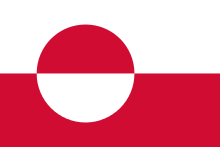

 Australian Aboriginal Flag
Australian Aboriginal Flag Flag of Bangladesh
Flag of Bangladesh Flag of Indonesia
Flag of Indonesia Flag of Japan
Flag of Japan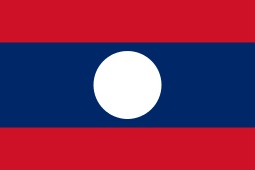 Flag of Laos
Flag of Laos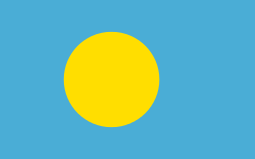 Flag of Palau
Flag of Palau Flag of Poland
Flag of Poland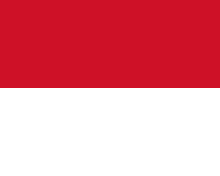 Flag of Monaco
Flag of Monaco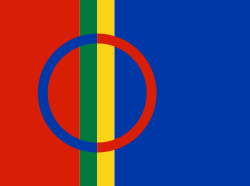 Sami flag
Sami flag



